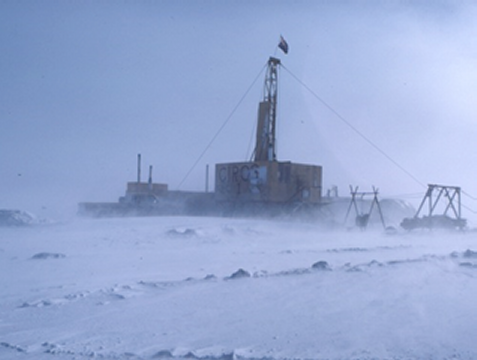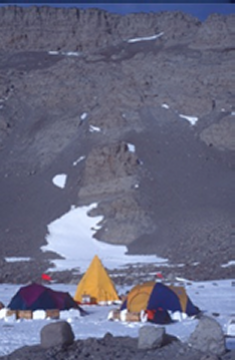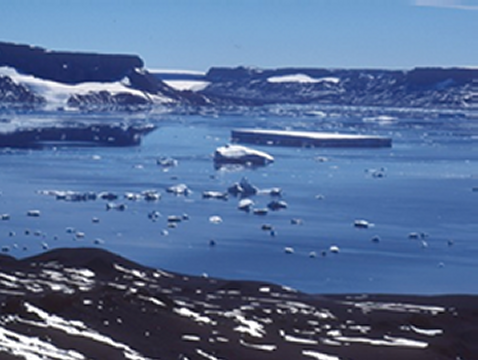Cenozoic glacial history of Antarctica
CfG staff: Hambrey, Michael
Key collaborators: Prof. Peter Barrett, Victoria University of Wellington, New Zealand; Prof. Werner Ehrmann, University of Leipzig, Germany; Prof. Barrie McKelvey, University of New England, Australia; Prof. John Smellie, University of Leicester; Prof. Peter Webb, Ohio State University, USA
A long-running research interest of Michael Hambrey has been the long-term history of glaciation of Antarctica. Over a period of 25 years, involving 12 field seasons, he has collaborated with the national programmes of New Zealand, Australia, America, Germany, the UK, and the international Ocean Drilling Programme (Leg 119) and the Cape Roberts Drilling project. He has thus worked in both the offshore realm and the interior of Antarctica, and produced many influential papers as a result, some of which are given below.
Drilling on the continental shelf of East Antarctica has demonstrated that large ice masses developed about 34 m.y. ago (Hambrey et al., 1991, 2002; Hambrey & Barrett, 1993) but were subject to large fluctuations through most of the later Cenozoic Era, stabilizing only in the Miocene or Pliocene epochs. Whereas the offshore records provide a relatively complete history of glaciation, by linking different boreholes, the onshore record is sketchier. Despite this, the geometry and character of facies associations is much clearer, and they provide snapshots of the status of glaciation at different times in the Cenozoic Era. The Prince Charles Mountains, bordering the world’s largest glacier system, record multiple glaciations and long-term landscape evolution in uplifted glaciomarine sediments stretching back to Oligocene time (Hambrey & McKelvey, 2000a,b). These observations link up well with the offshore record in Prydz Bay (Hambrey et al., 1991). Deep in the heart of Antarctica, the last outcrops of exposed rock before the Polar Plateau included diamictites that suggest polythermal glaciers deposited terrestrial glacigenic sediments in a tundra-like environment, i.e. under conditions much warmer than those of today (Hambrey et al., 2003), although the age of these deposits (Pliocene or older) has been much disputed. In the northern Antarctic Peninsula, particularly James Ross Island, marine and terrestrial glacigenic sediments are associated with vast outpourings of basaltic lava and hyaloclastite deltas, providing a unique window on the interaction between glaciers and volcanoes during the Miocene and Pliocene epochs (Hambrey et al., 2008; Smellie et al., 2008).

The CIROS-1 drillsite (1986) in the Western Ross Sea, which was the first to demonstrate the old age (£34 Ma) of glacial sediments in Antarctica.

Field camp with the US Antarctic Program of 1995/96, nestling below cliffs of Pliocene or older diamictite, interpreted as stacked basal tills, Shackleton Glacier, 85 degrees south.

James Ross Island, a volcanic edifice (basalt) built on soft Cretaceous sediments. The Pliocene-Miocene glacial deposits commonly occur at the foot of the volcanic cliffs, and amount to just a few metres in thickness.
Through these international activities, Michael Hambrey has had considerable involvement with the Scientific Committee on Antarctic Research (SCAR), most recently as Secretary of the Geosciences Standing Scientific Group, and as UK Geoscience delegate. Among recent activities has been to serve as chief editor of a major Antarctic volume arising, in part, from the last International Antarctic Earth Science Symposium in Edinburgh (Hambrey et al., 2013).
Selected references:
Barrett, P. J. and Hambrey, M. J. 1992. Plio-Pleistocene sedimentation in Ferrar Fjord, Antarctica. Sedimentology 39, 109-123.
Davies, B.J., Hambrey, M.J., Smellie, J.S., Carrivick, J.L., Glasser, N.F. 2012. Antarctic Peninsula Ice Sheet evolution during the Cenozoic Era. Quaternary Science Reviews 31, 30-66.
Hambrey, M. J., Ehrmann, E. H. R. and Larsen, B. 1991. The Cenozoic glacial record of the Prydz Bay continental shelf, East Antarctica. In: Barron, J., Larsen, B. et al. Proceedings of the Ocean Drilling Program, Sci. Results, Vol.119, College Station, Texas, pp. 77-132.
Hambrey, M. J. and McKelvey, B. 2000a. Major Neogene fluctuations of the East Antarctic ice sheet: Stratigraphic evidence from the Lambert Glacier region, Geology 28 (10), 887-891
Hambrey, M. J. and McKelvey, B. C. 2000b. Neogene fjordal sedimentation in the Prince Charles Mountains, East Antarctica. Sedimentology 47, 577-607.
Hambrey, M. J. and Barrett, P. J. 1993. Cenozoic sedimentary and climatic record, Ross Sea region, Antarctica. In: The Antarctic Paleoenvironment: a Perspective on Global Change, Part 2, ed. Kennett, J. P. and Warnke, D. A., Antarctic Research Series, American Geophysical Union, 91-124.
Hambrey, M. J., Barrett, P. J. and Powell, R. D. 2002. Late Oligocene and early Miocene glacimarine sedimentation in the SW Ross Sea, Antarctica: the record from offshore drilling. In O’Cofaigh, C. and Dowdeswell, J. A. (eds.), Glacier-influenced sedimentation on high-latitude continental margins. Special Publication of the Geological Society 203, 105-128.
Hambrey, M. J., Webb, P.-N., Harwood, D. M., and Krissek, L. A. 2003. Neogene glacial record from the Sirius Group of the Shackleton Glacier area, central Transantarctic Mountains, Antarctica. Geological Society of America Bulletin 115(8), 994-1015.
Hambrey, M.J., Glasser, N.F., McKelvey, B.C., Sugden, D.E. & Fink, D. 2007. Cenozoic landscape evolution of an East Antarctic oasis (Radok Lake area, northern Prince Charles Mountains), and its implications for the glacial and climatic history of Antarctica. Quaternary Science Reviews 26, 598-626.
Hambrey, M.J., Smellie, J.L., Nelson, A., Johnson, J. 2008. Late Cenozoic glacier-volcano interaction on James Ross Island and adjacent areas, Antarctic Peninsula. Geological Society of America Bulletin, 22pp. doi:10.1130/B26242.1. [March 2008].
Hambrey, M.J., Smellie, J.L., Nelson, A., Johnson, J. 2008. Late Cenozoic glacier-volcano interaction on James Ross Island and adjacent areas, Antarctic Peninsula. Geological Society of America Bulletin, 22pp. doi:10.1130/B26242.1. [March 2008].
Hambrey, M.J. et al. (eds.), 2013 (October). Antarctic palaeoenvironments and Earth-surface processes. Geological Society Special Publication 381.
Smellie, J.L., Johnson, J.S., McIntosh, W.C., Esser, R., Gudmundsson, M.T., Hambrey, M.J. and van Wyk de Vries, B. 2008. Six million years of glacial history recorded in volcanic lithofacies of the James Ross Island Volcanic Group, Antarctic Peninsula. Palaeogeography, Palaeoclimatology, Palaeoecology, 260, 122-148.
